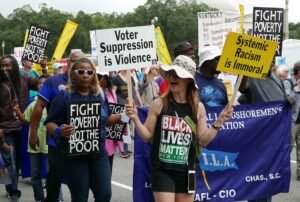Punitive, hostile, chaotic? You can attach these adjectives daily to the challenges nonprofits and immigrants have to address every day. Consider these milestones of the last week or two:
Case #1: At the various “town hall” meetings on health care reform where opponents get to vilify each other and imagine that a public option is a stalking horse for something akin to Stalinism, one of the big rumors is that health care reform will provide coverage to undocumented immigrants. CNN put its Truth Squad into action to reach the conclusion that the rumor is false, undocumented immigrants would not be covered in the version of health care reform (HR3200) making its way through the House of Representatives. So Senator Ben Cardin (D-MD) could feel right at home assuring town hall opponents that “illegal aliens will not be in this bill — period — the end,” in concert with similar pledges from Senator Kent Conrad (D-ND), Senator Mark Begich (D-AK), Senator Ben Nelson (D-NE), Representative David Boren (D-OK), and, unfortunately, President Barack Obama (who at least acknowledged that, despite the exclusion of illegals from health insurance coverage, simple “human decency” demanded that undocumented immigrants get some emergency care). Maybe our nation’s legislators, afflicted with moral and public health blind spots, think that undocumented immigrants will suffer their diseases out of sight, out of mind–and clearly without burdening our tax dollar by participating in the nation’s ever-weakening commitment to comprehensive health insurance reform.
Case #2: The August 15th Wall Street Journal described the growth of foreign-born baseball players in the minor and major leagues in the U.S. For example, 18 of 25 players on the roster of the Boise Hawks (in the Chicago Cubs system) were not from the U.S. Almost 3,500 professional baseball players under contract in the U.S. major and minor leagues are foreign-born. Thanks to George W. Bush who transformed himself from president and owner of the Texas Rangers to President of the United States, the Creating Opportunities for Minor League Professionals, Entertainers and Teams Act of 2007 allowed baseball team owners unlimited access to H2B work visas for foreign players. As long as they can pitch, field, or hit like they might make the big leagues, there’s no such thing as an illegal immigrant to major league baseball. But if they are looking for jobs in day labor centers or other venues, immigrants frequently face welcomes quite the opposite of their countrymen in organized baseball.
Case #3: During President Obama’s visit to Mexico to meet with Felipe Calderon, he announced that due to the “pretty big stack of bills” on his agenda, immigration reform would have to be delayed until 2010. Like the Administration’s efforts to backtrack from HHS Secretary Kathleen Sebelius who sort of ditched the President’s commitment to the public option in health care reform, the President has tried to backtrack from his Guadalajara summit statements that dismayed immigration reform advocates and disappointed his Mexican hosts, but the damage was done. The hint all along had been that, despite the energy of immigration reform advocates like Senator Chuck Schumer, immigration reform might not happen in 2009, and it looks less likely now.
So what are the lessons for nonprofits from the latest news headlines concerning our nation’s fits and starts with immigrants? Two obvious lessons:
Sign up for our free newsletters
Subscribe to NPQ's newsletters to have our top stories delivered directly to your inbox.
By signing up, you agree to our privacy policy and terms of use, and to receive messages from NPQ and our partners.
First, no matter how much evidence nonprofits can point to about communities that have welcomed and integrated immigrants, there is still plenty of venom toward immigrants in lots of venues. When scoring points against undocumented immigrants works for leaders of both major political parties as in the health care reform debate, we should all be aware of how much work there is to be done.
The second point is obvious for the nonprofit sector: As a sector, nonprofits need to start talking about immigration and immigrants. The silence of most nonprofits around immigration issues, even when they emerge in ostensibly non-immigrant policy discussions such as health care reform, is not healthy for the sector. Look at the websites of most of the national nonprofit “infrastructure” organizations for evidence that they have taken a stand on anything relating to the needs of immigrant populations (documented and undocumented) and the roles of nonprofits in responding. We don’t need conference agenda items about what “immigrant organizations” are doing; we need a sector discussion of how the nonprofit sector writ large–operating charities and public and private foundations–is standing up for human rights for the immigrants in our nation.
In the summer issue of Nonprofit Quarterly, we have a number of national and local nonprofit leaders taking on these issues as they affect all of us, immigrants and non-immigrant nonprofits alike. The authors take on the issues that so often our sector sidesteps:
- Eva Paterson, Claudia Pena, and Miguel Gavaldon of the Equal Justice Society question why advocacy for immigration reform seems to fall short of an agenda that embraces human rights and social justice for immigrants.
- Lisa Hasegawa and Gen Fujioka of the National Coalition for Asian Pacific American Community Development (National CAPACD) argue for the role of community development in helping immigrant populations establish themselves in U.S. communities.
- Noel Poyo and Analisa Nazareno of the National Association for Latino Community Asset Builders (NALCAB) describe how immigrant communities are organizing themselves to build economic power.
- Mari Ryono of the Mobilize the Immigrant Vote California Collaborative describes how youth leaders help immigrant communities engage in the electoral process.
- Dan Petegorsky and Kalpana Krishnamurthy of the Western States Center address how to make nonprofit voices more central to the immigration reform issue and movement.
- Young activists Tam Tran and Prerna Lal, the latter one of the founders of DreamActivist.org, point out the obstacles facing undocumented immigrants (like Tam) in attending college and advocate for the Dream Act as one of the needed mechanisms in immigration reform.
- Philanthropic leaders Geri Mannion (of the Carnegie Corporation) and Taryn Higashi talk about the roles that foundations can and should play to support immigrant communities, highlighting their work with the Four Freedoms Fund.
- Cynthia Garcia Coll and Flannery Patton of Brown University write about how to build on the strengths of immigrant youth.
- Online, we add additional articles, most importantly Elena Letona from the National Alliance of Latin American and Caribbean Communities (NALACC) discussing the mobilization strategies of smaller, community-based immigrant groups around the nation.
Why would Nonprofit Quarterly devote much of one of its quarterly magazine issues and a significant section of its website to the topic? Because unless our nation and the nonprofit sector come to grips with responding to the legitimate needs and aspirations of tens of millions of immigrants in our nation, we will as a nonprofit sector be failing in our sector-wide mission of social advancement and grassroots democracy.













